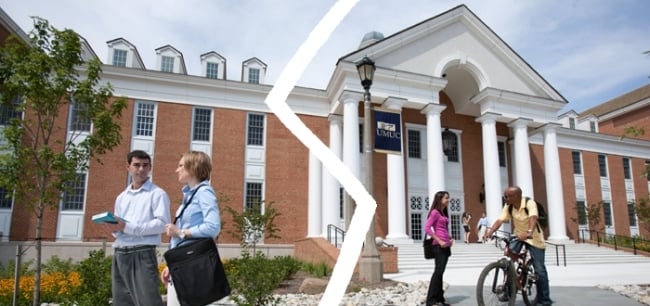You have /5 articles left.
Sign up for a free account or log in.

Photo Illustration
The University of Maryland University College is tearing itself apart -- on purpose.
The university, which gets nearly all of its funding from tuition revenue, has long relied on enrolling large numbers of students associated with the military for financial stability. After teaching students at military bases across Asia and Europe for decades, the university was quick to realize the potential of the internet and became a pioneer in the field of distance education.
After an enrollment dip earlier this decade, however, UMUC has begun a process of unbundling, paring the institution down to what President Javier Miyares calls its “academic core” to monetize its own services, grow its endowment and keep tuition rates low.
“We believe that if you look at higher education, there is a core -- what you teach, who teaches it and how we teach it,” Miyares said in an interview. “That is the existential, essential core of the university. Everything else are business processes that do not have to be run in the traditional way within the university.”
UMUC has already spun off its Office of Analytics, which in 2015 became the data analytics company HelioCampus. It has plans to do the same with its IT department and the 100 or so staffers in it, who will form a company called AccelerEd. Other units may follow.
The university’s unbundling strategy is controversial, and it has already attracted questions about how a public institution can justify privatizing parts of what it does. UMUC, in response, points to the governance structure it has set up with the state to ensure that the university and other public institutions in Maryland will be first in line to benefit from the changes.
Moreover, Miyares said, the changes are necessary in order for the university to fulfill its mission of providing higher education to working adults as long as only about 10 percent of its funding comes from the state.
“In higher education today, almost every institution is looking at its business model, and those who are not should be doing that,” Miyares said. “I would argue -- and I think a lot of folks would agree -- that a public institution that bets its future on increasing public dollars is putting itself at risk.”
Rebounding From the ‘Perfect Storm’
UMUC’s decision to spin off units and offices not directly related to teaching students dates back to strategic shifts the university made following a period of decline earlier this decade.
“We found ourselves in what I called at the time ‘the perfect storm,’” Miyares said.
There was sequestration -- the automatic federal budget cuts triggered in 2013 when a “super committee” of lawmakers in Congress failed to agree on a deficit-reduction plan. Then the federal government shut down for 16 days in October, forcing the branches of the military to stop processing tuition assistance applications.
Those events compounded with longer-term developments, including the military drawdown and increased competition in the online education market.
The result: UMUC lost thousands of students, especially at military bases in Asia and Europe, which posted double-digit enrollment declines. The university cut its work force by about 300 and its budget by around $60 million, and tasked a working group of entrepreneurs and board members with reviewing its business model.
The group, known as the Ideation Team, produced a grim conclusion: “UMUC is no longer well positioned for long-term sustainability in this new environment.”
UMUC’s enrollment has since begun to rebound. Its worldwide unduplicated head count during the 2016 fiscal year was 85,122, down about 12,000 since its peak in fiscal year 2012 but up about 3 percent from fiscal year 2015.
The university’s share of students connected to the military -- active-duty service members, veterans and their families -- has also grown. Those students now comprise between 50 and 60 percent of its total enrollment, yet they are not the answer to UMUC’s long-term challenges, Miyares said.
“There is no future there,” Miyares. “We certainly want to keep expanding our market share of military enrollments for many reasons -- among them the historic identity of UMUC -- but our future is in the civilian space.”
Spinning Off to Grow
UMUC has a number of ways to market itself to adult learners, including low tuition rates ($248 per credit hour for in-state students, $499 for out-of-state students) and generous transfer credit policies. Last year, the university did away with commercial textbooks and replaced them with free open educational resources. It is also redesigning several of its academic programs to emphasize practical, “experiential” learning, Miyares said.
However, it is the university's proposed changes on the administrative side that may insulate it somewhat from the effects of ups and down in its enrollment.
The Ideation Team evaluated seven potential business models, ranging from UMUC merging with another public institution in the state to selling it to a competitor. The model that the team recommended, which the university is now pursuing, aims to combine the security of being a public institution with the risks and rewards that the private sector affords.
UMUC has set up a nonprofit, UMUC Ventures, which functions like a holding company whose purpose is to benefit the university. It, in turn, controls AccelerEd, HelioCampus and whatever companies the university will spin off in the future.
As those companies sell their services to other colleges, the university hopes to use some of the profits to grow its endowment. At around $16 million, the endowment is much smaller than national median of about $120 million.
“We believe that one of the benefits of this new construct is that it provides an avenue to significantly grow [our] endowment,” Miyares said. The university doesn’t have endowed chair positions or a prestigious research institute that it could promote to encourage alumni to donate, he pointed out (generally, the university’s faculty members are on three- to five-year contracts).
Miyares declined to say which other university functions may be spun off, adding that it is “fair to say that [the IT department] will not be the last.” But that depends on whether the units can be turned into profitable businesses, he said.
“What is totally untouchable is what we call the academic core of the university -- the faculty, the schools, the curriculum, the library, the registrar and the military contracts we have with the Department of Defense to provide overseas education,” Miyares said. The university “will consider anything else … that can offer opportunities, first, in a more flexible way outside of state constraints and, second, that offers the possibility of capitalizing, monetizing that intellectual property,” he said.
Privatization and the Public Mission
UMUC’s unbundling strategy has its supporters, particularly among people who say colleges are becoming too bloated.
Ryan Craig, managing director of the investment firm University Ventures, argued in College Disrupted: The Great Unbundling of Higher Education that college spending on efforts not directly related to academics -- including athletics and research -- is making higher education unaffordable to many students.
“UMUC recognizes that higher education institutions have an obligation to students to reimagine how they achieve their missions,” Craig said in an email. “Too much of college and university spending is currently allocated to functions that do not directly serve the interests of tuition-paying students. Isomorphism of organizational structures, processes and even credentials has produced a self-referential system that is failing too many students at too high a price. In unbundling the university, UMUC will complete the prerequisite to [provide] faster, cheaper and more effective educational pathways for students.”
But the strategy also has its critics. George Kroner, a former UMUC employee, in a blog post expressed concern that the university appears to be gambling with public funds.
“As much respect as I have for the university president, he seemed quite enamored with finding ways to use public resources to found private educational-technology start-up companies -- instead of with the core academic mission of the university,” Kroner wrote. “The thinking was that the university might use excess income from these start-ups, or the proceeds from selling them off, to fund scholarships. This is a noble goal, but the business of ed tech is extremely risky at best and can result in losing hundreds of millions of dollars for even the largest and most successful educational-technology companies.”
Kroner added that he likes the idea of harnessing the talent in UMUC’s IT department, but that he disagrees with the university’s approach.
“As a taxpayer of Maryland, I think of UMUC as a state treasure,” Kroner wrote. “The university has a special academic mission, and I hate seeing it put on the back burner. I don’t want to see the great work of UMUC privatized.”
Miyares said UMUC spinning off its analytic and IT units is no different than a college outsourcing its food or facilities management services. “The public mission is providing access to higher education,” he said. “The public mission is not if we get IT services from an affiliated private company.”
Miyares pointed to the hierarchy that connects the spun-off companies to the university and the state. UMUC Ventures is governed by its own Board of Ventures, members of which are named by the university president, who is named by the University System of Maryland Board of Regents.
The arrangement still creates some distance between the university and the companies under its control. If HelioCampus were still the Office of Analytics, the administration could tell it what to prioritize. Now, those priorities have to be carefully detailed in the university’s contract with the company.
Miyares acknowledged that the university is still tweaking the model and learning as it goes along, but that it is so far satisfied with the results.
“For the regents, it was important that there was a really clear line of control,” Miyares said. “We are very satisfied that what we are getting from [HelioCampus] in terms of analytics services is what we were getting before, but that involved very well-crafted service-level agreements. The same thing will have to be done with IT … to make sure we continue to get what we need. At the end of the day, if we don’t, well, I can appoint new directors at any time.”
And if the regents have issues with the university’s strategy? “In Maryland, presidents don’t work on contract,” Miyares said. “We can be fired tomorrow.”








